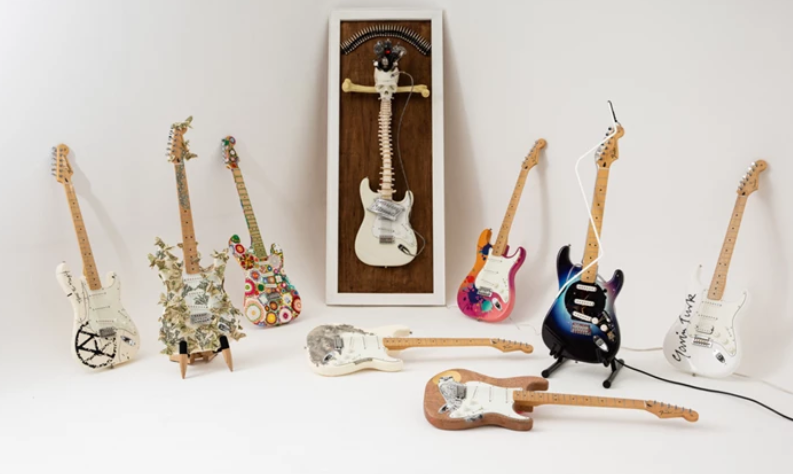So firstly, what is a custom object? In this context we are talking about a non-traditional art object that has been customised by an artist. They’ve decorated or redesigned it in their iconic style.
Putting a value on something this unique is hard. There is often no market precedent for the artist working in this format and the unique nature of the artwork could either enhance or devalue its appeal - as collectors prefer artwork for which the artist is better known.
But if priced correctly, it is incredibly exciting to have such a unique object to auction with results far exceeding expectations. So to help navigate this delicate subject, we’ve put together some key factors for you to consider.
Cedric Christie, Nancy Fouts, Rob and Nick Carter, Gavin Turk and their customised Centre Point Letters: View Auction
Estimate vs Reserve
Before starting, it is important understand the difference between an auction estimate and a reserve. The estimate reflects the value of the object, and the reserve is the actual price at which you can buy it – the starting price. Addressing these separately is particularly important for custom objects as you want to show how valuable and important they are, but you also want them all to sell.
Setting the Estimate
Does the object have an inherent value?
Whilst not necessarily influencing the reserve (starting price), the known value of an object in its untouched state can help guide the low estimate as this is what the objects are worth on their own. For example, these turntables in the Planar 1/1 auction had a base value of £500.
Has the customisation increased the value of the object?
In general, if an object has been ‘enhanced’ by a well-known artist then its value should increase. However, sometimes the customisation can lessen the object’s appeal to buyers particularly if it is a collectible in its own right (such as a watch or a classic car).
This can also happen if the customisation stops an object from functioning. This immediately limits the number of interested buyers. So, we would always recommend that your brief to artists includes a request that the object still functions after it has been worked on.
Planar 1/1 and The Big Art Auction contained both functioning and non-functioning turntables and electric guitars as a result of the custom designs.
Is the item easy to own?
This is a question that is key for all auction items. It may be an incredibly creative and beautiful piece, but how easy is it to display, maintain and insure. The harder and ‘less domestic’ it is, the smaller the audience with the ability to own it.
The Doodle Bull was an incredible collaboration and a beautiful object but not everyone has space for a non-functioning F1 car. However, the audience that did have the space inevitably had larger budgets - a smaller audience but with a bigger spending power.
Mr Doodle customising the Red Bull Racing RB14 show car.
What is the range of artists like?
Considering all of the factors mentioned above, there are many factors that can affect the appeal of a custom object and so it’s value. An established artist at the top of the market might only add a small touch to their object, yet a relatively unknown artist might create a masterpiece that attracts much more interest from bidders.
For this reason, and to highlight the fact that the objects are so unique and outside the scope of the artists normal oeuvre, we would recommend giving the items all the same estimate and starting prices. You can bend the rules of traditional estimate setting and create a larger than normal estimate range. Be guided by the most valuable artist in the room and base the high estimate around their pricing and the low estimate at the lowest value artist or the items original worth.
This ‘levels’ the auction and really does let the bidders decide the ultimate value for each piece. This strategy also stops an awkwardness between artists as they compare their estimates to others.
Every brain sculpture in Me, My Brain and I had the same wide-ranging estimate of £2,000 – 20,000.
Setting the Reserve
The hard truth is that by being so unique and having no previous auction precedent, there should be no expectations on price. The market will decide what the objects are worth when the auction happens. This means setting a high reserve to reach an expected target can be a risky strategy. The easiest way to think about this is based on two questions:
Is the auction for charity?
If so, then it is just about raising as much funding as possible and that means selling everything in the auction. You need to ‘price to sell’.
Do you have a ‘no sale’ post-auction strategy?
I.e., what is the plan if the items don’t sell? If there isn’t a ‘no sale’ strategy then consider offering the items with no reserve to guarantee they sell. Don’t forget, you can still include an estimate to show the true value of the pieces.
Will the price of this effect the artists market?
No. These are unique objects that are outside the traditional market for the artist.
Summary
- Keep all estimates and starting prices the same for all artists
- Consider the commercial appeal for each item
- Use the value of the object as a guide for the low estimate
- Use the pricing for the most valuable artists as a guide for the high estimate
- Price to sell by having low or no reserves
-
For more auction advice and the latest lessons learnt from our sellers running auctions, join our monthly 'Auction Insights' newsletter.







